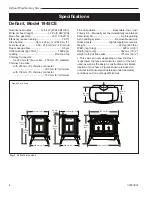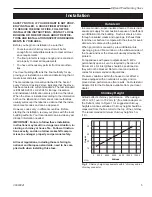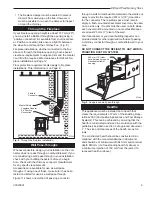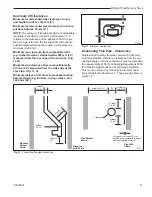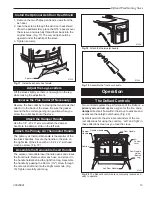
18
Defiant Woodburning Stove
30003841
ST264
good fire
12/99
ST264
Fig. 27
Add larger pieces of wood as the fire begins to burn
well.
ST264a
add wood fire
11/00
ST264a
Fig. 28
Add full size logs after the ember bed is 3” (75mm)
deep.
4. Close the damper.
5. When the surface temperature reaches 230° C
(450° F), adjust the air control for the amount of heat
you desire.
NOTE:
If the remaining charcoal bed is relatively thick
and if your fuel is well seasoned, it is possible to add
fresh fuel (smaller pieces first), close the door and
damper, and reset the primary air thermostat for the
desired heat output.
CAUTION: The Defiant will be hot while in opera-
tion. Keep children, clothing and furniture away.
Contact may cause skin burns.
DO NOT OVERFIRE THIS HEATER.
Overfiring may
cause a house fire, or can result in permanent dam-
age to the stove and to the catalytic combustor. If any
part of the Defiant other than the baffle and/or catalytic
combustor glows, you are overfiring.
The throat is made of a special cast iron which can
withstand higher temperatures than most other parts
of your stove. It protects the catalytic element from
direct flame impingement, which can shorten the
catalyst’s life. Since the throat is in the direct path of
flame between the firebox and the catalyst, it reaches
higher temperatures than other firebox parts, and it may
glow at times. If it does glow, you will see this directly
through the front doors. The glow is normal and does
not indicate a problem.
At times you may see a glow from the catalyst shining
through the ports of the throat. This is also normal and
does not indicate a problem. The catalytic element,
located below and behind the throat, can glow at high
temperatures. This is also normal. However, the ele-
ment can be active and operate properly without glow-
ing. The lack of a glow does not indicate that the cata-
lyst isn’t working. Note that the catalyst is most likely to
glow at its higher temperatures, which it reaches when
the firebox is in its lower range - the catalyst is an after-
burner, and the more waste fuel there is in the smoke,
the hotter the catalyst gets.
We strongly advise the use of a stove-top thermometer
as a guide to stove performance. Normal operating
temperatures are between 220° C (450° F) and 370° C
(700° F). Lower temperatures can indicate incomplete
combustion and weak draft; higher temperatures can
shorten the life of the castings.
Ash Disposal
Routine ash removal is important for ease of main-
tenance, and is important for the stove’s durability.
Remove ash before it reaches the top of the ash pan.
Check the level at least once a day. Every few days,
clear any ash from the outer edges of the firebox. Most
of the ash will fall through the grate. Slice or stir the
ash with a shovel or poker so that it falls through the
grate slots.
Do not break the charcoal into very small pieces or
pound or compress the charcoal bed.
It is important that air can circulate through the charcoal
bed during the burn. Larger pieces of charcoal allow
more air to circulate under the wood, resulting in the
fire reviving more quickly. (Fig. 28)
For best results when refueling, wear long-cuffed stove
gloves to protect your hands and forearms, add fuel
while the stove still has plenty of glowing embers to
re-kindle the fire, and include some smaller pieces of
wood in the new fuel load to help the stove regain its
operating temperature quickly. Use this sequence as a
guide to successful refueling:
NOTE:
Door handles can be hot. A glove has been
included with your stove. We recommend using this
glove whenever operating door or damper controls, and
especially when operating the top griddle.
1. Open the damper.
2. De-ash the stove as described above. Open the
ashdoor and check the level of ash in the ash pan.
Empty the pan if necessary and replace it in the
stove. Close the ash door.
3. Open the griddle, load the wood (smaller pieces
first), and close the griddle.

